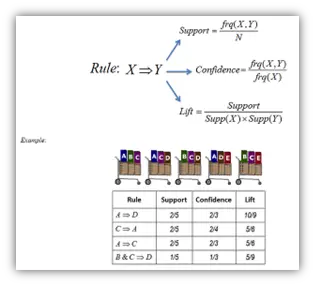
Sign up to receive latest insights & updates in technology, AI & data analytics, data science, & innovations from Polestar Analytics.
Editor’s note: Forget dusty market basket analysis techniques. Since Generative AI is inevitably making a buzz around everything marketer’s set their eyes upon, sitting with our thinking hats might give us something on how data science methodologies are being given a flip with GenAI. Get ready for smarter recommendations, hyper-targeted campaigns, and an unfair advantage over your competition – blow up your retail game in the process!
For decades, Market Basket Analysis (MBA) has been on the wish list of every retailers (to understand customer purchase patterns and make informed business decisions) but only handful are being pushed to the extra mile to find out:
It’s a simple yet significant analysis – Understand which customers tend to purchase items that complement each other. For example, customers who purchase bread are likely to also purchase butter, jelly, and cheese. But as we skip to 2024, traditional Market Basket Analysis (MBA) techniques are likely to fall short.
Now sprinkle a pinch of generative AI on the top and this engine can easily transform into a powerful recommendation automata. (Hello J.A.R.V.I.S/F.R.I.D.A.Y/E.D.I.T.H !)

If you are familiar with Market Basket Analysis and the data science framework in the backdrop,
skip to the inevitable disruption caused by Generative AI for retailers >>>
But, let’s understand first, How Does Market Basket Analysis in Retail industry Work?
Understanding Lift, Confidence and Support – the pillars of Market Basket Analysis
Traditional market basket analysis in retail relies on existing purchase data to uncover patterns and correlations. By using these metrics in conjunction, retailers can gain valuable insights into customer behaviour and make data-driven decisions to improve their business. For example, identifying item sets with high support and confidence can help in Product placement, Cross-promotions and Targeted recommendations.

Lets go back to breakfast table to understand the concepts
Support measures the frequency of an itemset appearing in transactions. It's simply the percentage of transactions containing a specific set of items. For example, if bread and butter appear together in 10% of all transactions, the support for the "bread & butter" itemset is 10%. Higher support indicates a more common association between items.
Confidence tells you how likely it is that customers who buy one item (antecedent) also buy another item (consequent). So, if 80% of customers who buy bread also buy butter, the confidence for the rule "bread -> butter" is 80%. High confidence suggests a strong association between the antecedent and consequent.
Lift takes things a step further – it essentially compares the observed support for an itemset with the support you would expect if the items were independent. A lift value of greater than 1 indicate a positive association (items are bought together more than expected), while values less than 1 suggest a negative association (items are bought together less than expected).
While traditional methods have served us well, they have limitations.
Traditional rule-based Market Basket Analysis (MBA) identifies item co-occurrences but struggles with complex relationships and causality. Generative AI introduces Probabilistic Graphical Models (PGMs), Recurrent Neural Networks (RNNs) and Causal Inference Techniques to disentangle causal relationships between promotions, product placements, and purchase decisions.
| Functions | Challenges | Generative AI Solutions |
|---|---|---|
| Data Acquisition & Preparation | - Sparse data & infrequent buys - Incomplete or inaccurate data - Difficulty segmenting customers |
- Generate synthetic transaction data to enrich sparse datasets - Impute missing values & correct inconsistencies with realistic data - Create virtual customer profiles for targeted analysis |
| Algorithm Selection & Parameter Tuning | - Identifying optimal algorithms for specific goals - Choosing appropriate support & confidence thresholds - Lack of interpretability in complex models |
- Auto-tune algorithm parameters based on desired objectives - Generate explainable models with reasoning capabilities - Suggest alternative algorithms based on data characteristics |
| Pattern Recognition & Interpretation | - Identifying spurious correlations & false positives - Overfitting due to limited data - Difficulty understanding complex interrelationships |
- Detect & filter out spurious associations using anomaly detection - Generate counterfactual scenarios to examine causality - Visualize patterns in high-dimensional data with interactive dashboards |
| Actionable Insights & Decision-making | - Translating insights into practical recommendations - Prioritizing actions based on impact & feasibility - Overcoming cognitive biases in interpreting results |
- Recommend specific product placements, promotions, or cross-sell strategies - Model potential outcomes of different decisions based on simulated data - Use human-in-the-loop approaches for bias mitigation & joint decision-making |
| Ethical & Privacy Considerations | - Data privacy concerns & consent requirements - Potential for discriminatory biases in generated data - Lack of transparency in AI models |
- Build models with privacy-preserving techniques like federated learning - Implement fairness guarantees and mitigate biases in data & algorithms - Provide clear explanations & justifications for AI-generated insights |
Revenues getting a lift: Identifying customer journeys and hidden purchase patterns – businesses can personalize the shopping experience to increase conversion rates and average order value by suggesting products most likely to resonate with individual customers.
Improved customer satisfaction: Personalized recommendations and relevant product suggestions enhance the customer journey and foster loyalty.
Reduced stockouts and overstocking: By predicting future demand accurately, businesses can avoid costly stockouts and overstocking, optimizing inventory management.
GenAI could play a big role in devising the strategy for perishables – processing external data like weather patterns, holidays and social media trends are likely to polish predictive market basket analysis for the decade to home. AI can suggest targeted promotions and discounts for specific products nearing expiry, driving sales and reducing waste.
Better decision-making: AI-powered insights provide a deeper understanding of customer behaviour, enabling businesses to make data-driven decisions across all aspects of their operations.
While generative AI holds immense promise for revolutionizing Market Basket Analysis (MBA)), it also raises important ethical considerations that need to be addressed responsibly. Here are some key avenues to ponder upon:
Addressing these ethical considerations through careful planning and implementation is essential to ensure that generative AI is used for good in the context of Market Basket Analysis (MBA).
Generative AI is poised to offers businesses a head-start to making sense out of valuable customer insights, predict future trends, and personalize the shopping experience. At CES 2024, Walmart unveiled their innovative Generative AI search technology, aiming at improving the online shopping experience. Imagine being able to shop based on your needs instead of product-based. This new feature, developed using Microsoft AI models and Walmart's shopper data, enables a seamless and natural shopping experience.
While it's just an AI-based UX feature debuted by Walmart to make shopping convenient, I is expected to unravel scarcely used benefits of Market Basket Analysis for D2C e-commerce brands.
Typically, new-age D2C brands rely a lot upon awareness and education as they introduce newer categories of consumer products.
But, if they can effectively train AI models using their proprietary data, they can make product discovery frictionless, and we can expect even more innovative applications of AI in Market Basket Analysis, leading to a new era of customer-centricity and retail success. benefits of market basket analysis.
About Author

Sports and Tech Enthusiast
In a world of opinions and cold numbers, data tells a compelling story.